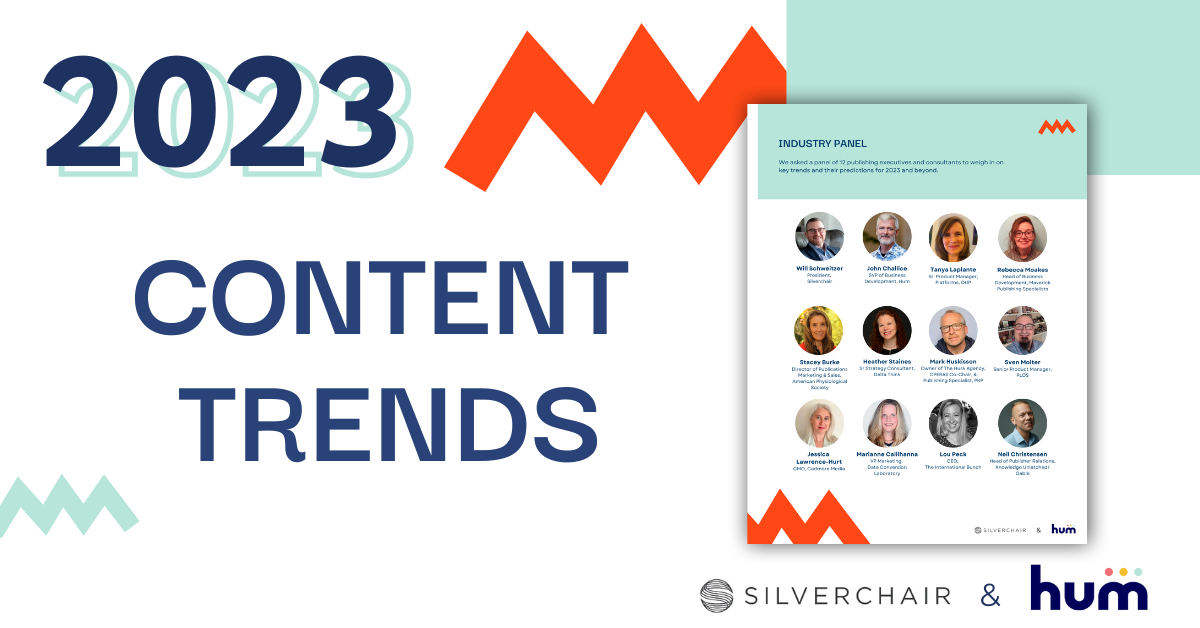Below, read excerpts from the report about the trends they expect to see related to scholarly and professional content: how it's distributed, monetized, packaged, and more.
What do you see as the number one challenge for digital content publications in 2023?
Content gluttony. Ever-increasing output naturally creates downward pressure on value per publication unit unless publishers understand how to extract value from all that inventory. —Neil Christensen
Just doing something that moves in the strategic direction, instead of thinking they have to spend an entire year - or more - figuring out a plan. Strike while the iron is hot/the content is fresh! —Jessica Lawrence-Hurt
Discovery and findability. The corpus of papers increases exponentially year over year. Publishers need to deliver content in a seamless, automated manner to their platforms and discovery vendors. —Marianne Calilhanna
Uncertainty around the policy and funder environment. —Heather Staines
Open Access and navigating that world in a way that honors commitment to openness, while retaining revenue by illustrating to institutional customers why subscriptions to content that is largely OA is still beneficial to their constituents. — Tanya Laplante
In what ways will we likely see publishers' content priorities shift in the year ahead?
Multimedia and events-based content will grow in priority – all optimal ways to engage with users and generate a quick feedback loop.—Jessica Lawrence-Hurt
New content formats. Why does content have to be an article, book, conference paper, review etc? As long as the content is indexed and tagged in a certain way, we can have more flexibility in how we present it to the explorer, and how they digest it. —Lou Peck
We’re headed into a year of financial and market uncertainty. In times like these, conservative organizations (publishers included) want to retrench and cut back R&D investment and won’t launch new products; I think they should do the exact opposite. I think that uncertain times are the ideal time to adapt and innovate, and try out things because it’ll leave you in a better position when the market recovers. —Will Schweitzer
We need to move outside of what we have always done and think about partnerships that make us understand and target our audiences better. —Stacey Burke
They will want and need to extract more new value from their existing and growing content assets. The traditional models of roughly publishing more units at increasing prices and at lower expense are a downward spiral and a waste of knowledge. —Neil Christensen
In what ways will we see publishers' priorities for delivery and dissemination of content shift in the year ahead?
It's wishful thinking but I would really like to see the elimination of the PDF! Who reads PDFs? Have any publishers invested in serious research to answer PDF usage among its readership? —Marianne Calilhanna
Mass market channels that don't surface scholarly content won't cut it. We’ll see publishers apply scholarly apparatus to a broader array of content types. Improved recommendations & user targeting. —Jessica Lawrence-Hurt
Focusing more on providing content (& metadata) where users already are. Generating robust metadata for machine readability. —Heather Staines
Metadata improvements, more purchase options, & accessibility.—Rebecca Moakes
Finding international content for the market, or content suitable for an international market. —Sven Molter
In what ways will we see publishers monetize content in 2023?
I think we’re going to see more creative one-time rather than subscription sales. The backflow model has been really successful for publishers for far longer than any of us thought, and libraries or institutional customers continue to have one-time money to spend. Very few publishers have launched successful B2C product extensions or offers but I hope publishers continue to experiment with these. —Will Schweitzer
More institutional deals. —Sven Molter
New content services, new licensing opportunities and new products.—Rebecca Moakes
Events around content, in collaboration with education colleagues.—Jessica Lawrence-Hurt
Upstream attention to journal selection and editorial services for ESL researchers. Promotional offerings, including plain language and lay summaries. Content syndication around thematic issues that could include ads and related services. —Heather Staines
Monetizing grey lit/non-traditional content. Perhaps monetizing services around the content, offering different scales of access from standard to premium (e.g. the latter comes with epub download options). —Tanya Laplante
For my clients it is exactly the opposite – they're firmly working against the monetization of content. It is not the norm in the EU, ANZ, Latin America, etc.—Mark Huskisson
For more insights into the year ahead, download the full report here.
